 Vessel of Remembrance |
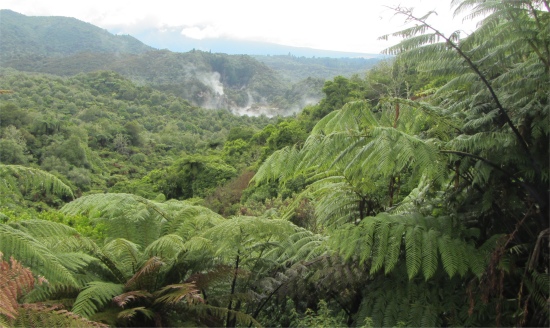 Looking Down Waimangu Valley Towards Cloud Covered Mount Tarawera |
Waimangu is the only hydrothermal system in the world, the commencement of whose surface activity can be pinned down to an exact day, namely 10th June 1886. On that day a violent volcanic eruption punctured the country in this locality with a series of craters, and allowed geothermal fluid already present underground direct passage to the Earth's surface. Since the time of their formation, development of the new geothermal features have been recorded.
The Waimangu Geothermal System is the newest geothermal system in the world, and the only one wholly created as a direct result of a volcanic eruption. The evolution of the Waimangu Ecosystem has been carefully recorded, giving a unique record of the establishment of a new ecosystem.
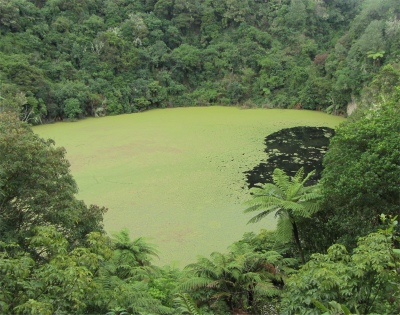 Emerald Pool in Southern Crater |
Ruaumoku represents earthquakes and all volcanic phenomena.
It is by these means that man feels the trembling of the unresting child within Papatuanuku (Earth Mother).
Ruaumoku is the unborn child of Papatuanuku (Earth Mother) and Rangi (Sky Father). Papatuanuku was pregnant when she was turned face down to Rarohenga (the Underworld or Spirit World). Hence Ruaumoko never emerged into the upper world or saw the light of day.
Ruaumoko, together with Whiro his brother, makes wars against the offspring of Tane (mankind) to avenge the separation of their parents (Earth and Sky). Whiro suggested that they should return to ao turoa, the upper world, to fight. But Ruaumoko said, "You belong to the upper world. Go you thither and fight, But I belong to the under world and I will conduct my own warfare." Whiro inquired, "But what weapons will serve you?" Replied Ruaumoko, "I will procure one from Puna-te-waro, where-in is conserved ahi-komau" (subterranean Fire, also known as ahi-tipua, supernatural fire).
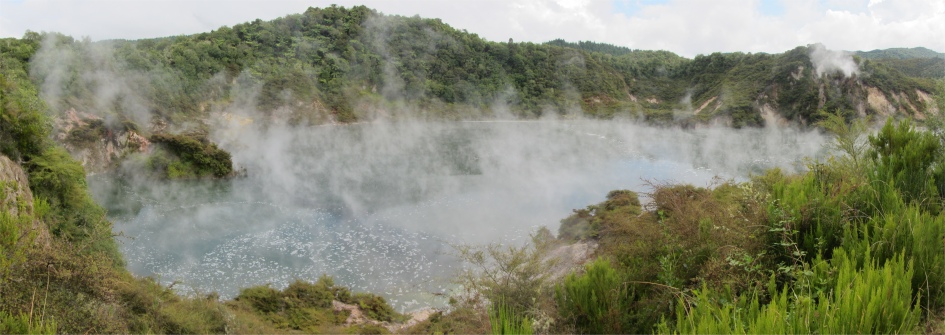 Frying Pan Lake Inside Echo Crater , the World's Largest Hot Water Springs |
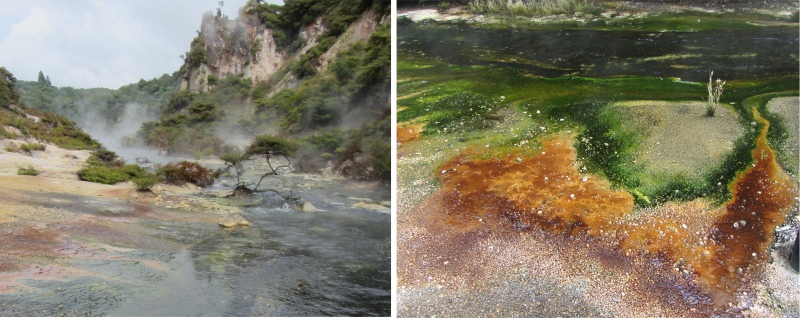 Mineral and Algae Deposits at Hot Water Creek |
Ngati Awa people believe that Ruaumoko is also the origin of thunder, which he uses to separate summer and winter.
Ruaumoko took Hine-nui-te-po as his wife in the underworld. This is curious because, while Ruaumoko is the destroyer of mankind, Hine is the protector of the spirits of the dead.
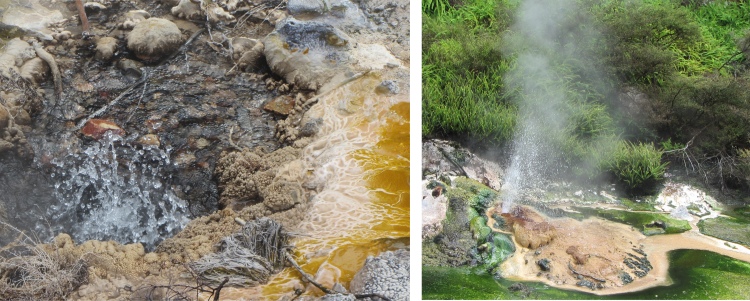 Boiling Fountains Everywhere |
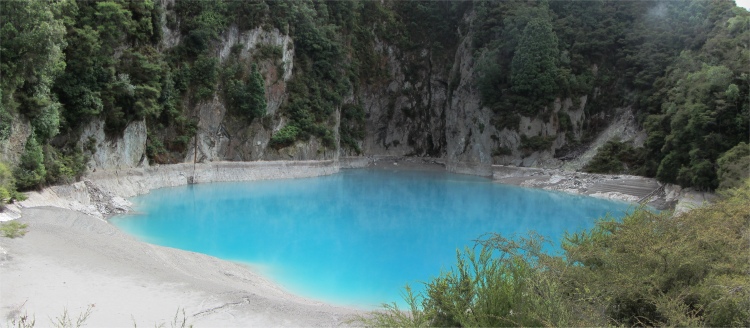 Inferno Crater Lake |
Lower down still I came across Echo Crater and Frying Pan Lake. Echo Crater is an elongated crater originally excavated by the 1886 Tarawera eruption sequence, and it has been reshaped by subsequent hydrothermal explosions.
The hot water and steam comprising the geothermal fluids discharges at Waimangu and all the other high temperature systems in the Taupo Volcanic Zone is dominantly rainwater that has percolated down through the relatively porous rock found in this region. At depths of between 5km and 10km, it has been heated by conduction from magma residing even deeper. Such heating makes water more buoyant and it rises in a convective plume towards the surface, on the way dissolving minerals from the rock through which it passes. A small proportion of water is probably volcanic in origin, and so there also will be some minerals and gasses such as carbon dioxide and hydrogen sulphide.
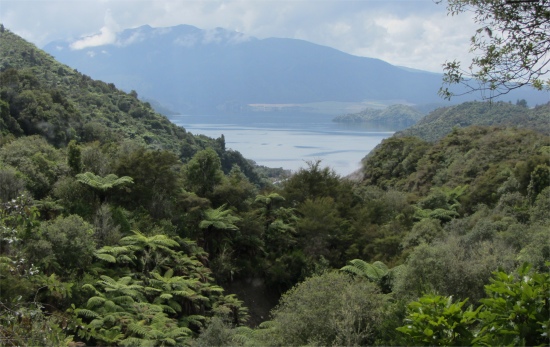 Looking Down Rift Valley to Lake Rotomahana and Mount Tarawera |
By the late 1890s, erosion of the soft volcanic material covering the surrounding land gradually filled the floor of Echo Crater with sediment until the lakelet had been almost completely displaced. Visitors to the Waimangu Geyser could walk across the resulting thermally active sandy floor, which became known as Frying Pan Flat, and could this way approach the crater of the Waimangu Geyser during its quiescent stages.
The hydrothermal eruption of 1st April 1917 re-excavated the south-western end of Echo Crater, almost completely blowing away Frying Pan Flat. The new basin formed by this outbreak quickly filled with rain water and with geothermal fluids discharging from vents in its floor, and formed Frying Pan Lake as we see it today. Covering 38,000 sq. metres, it is the world's largest hot spring. With an average depth of 6m, the lake contains 200,000 cu. metres of bubbling, steaming liquid with an average temperature of 55�C.
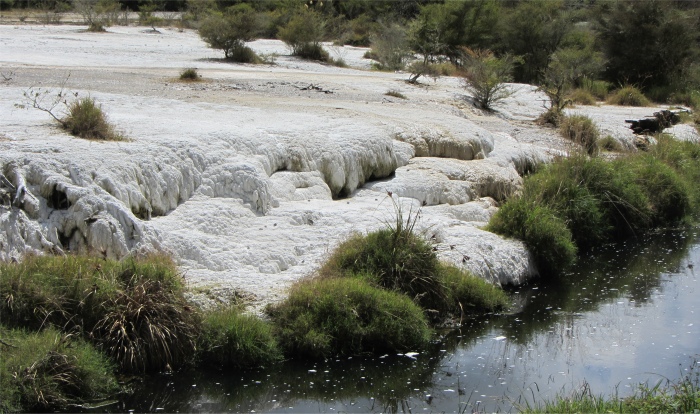 Marble Terrace |
The outflow of the Frying Pan Lake flowed through a notch at Hot Water Creek and Springs, at a temperature of 50�C with a throughput of 110 litres per second. Along its margin the stream formed deposits which contain traces of elements such as antimony, molybdenum, arsenic and tungsten. These minerals, along with blue-green algae, form spectacular orange, brown, green and yellow colours along the edge of the hot springs.
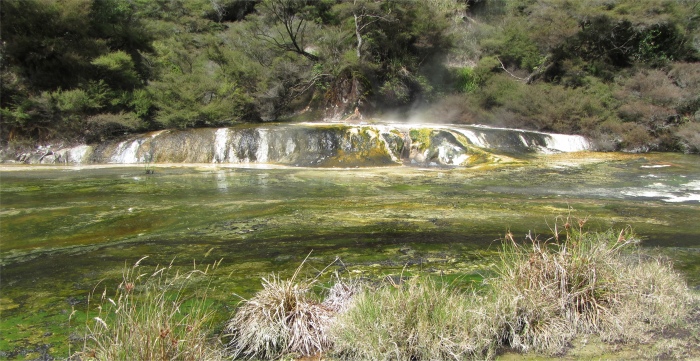 Warbrick Terrace |
The steaming, pale-blue jewel of Waimangu lies in an 1886 crater blown in the side of Mount Haszard. The lake level follows a complicated rhythmic cycle, with lake levels changing by as much as 12m over a 5-7 week cycle. Today it was half full, or half empty, depending on your outlook in life, but despite that, the colour and setting were stunning.
At this point I opted to follow the Mount Haszard hiking trail, which skirted around the side of the blue lake, and climbed up over the mountain, taking in another panoramic view of Echo Crater, and also a good view down the Rift Valley along the line of craters formed.
More craters along the rift came into view along the trail, namely the 56m deep Fairy Crater and the Black Crater.
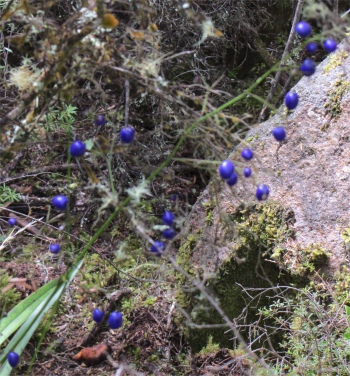 Pretty Berries |
I carried on to another set of terraces at the Warbrick Terrace, named after Alfred Warbrick, reputed to have been born on the shores of old Lake Rotomahana, and spent 45 years as a guide in the Rotorua region.
As I've said before, I'm a sucker for geology, and I found the Waimangu Geothermal System marvellous: its history, and how the subsequent geology and ecosystem has been recorded. It is well worth the visit.
I returned back to camp in what was now brilliant sunshine, and decided to just chill out rather than dash off to the next location. I spent a while in one of the thermal pools, which initially made my skin tingle. A family joined me: a chap, his wife, his sister-in-law and the latter's grandson. The chap was outnumbered, so we struck up a conversation quite quickly. He originated from near Cardiff, but he moved to Australia with his parents when he was quite young. He still had a fondness for his old country, and liked to visit when he could, but he would never move back. "Who did you support during the Rugby World Cup?" I asked, tongue in cheek. "Lots of people asked me that question. I never gave an answer until after the game," he laughed, as he slowly slipped into a Welsh accent. "My father used to play for Wales as a schoolboy. He was small, played on the wing, but he was fast, really fast. That was a long time ago, early 1930s I think. He won't watch rugby now, he says it is not the same game that he used to play," he added.
He recounted an amusing story about the village dances where he lived just outside Cardiff, the night when Tony Dawson (I think that was the name) was singing in a rock-and-roll band as a fifteen year old. Sadly I dare not relay the story here in case I fall foul of libel actions. Suffice it to say, that young singer went on to become Tom Jones. How he laughed.
The chap had been given his instructions by his wife, and had to leave; they were taking the grandson to a Maori entertainment evening and a hangi - it was the lads first time out of Australia.
